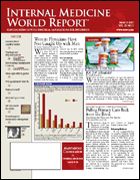Publication
Article
Internal Medicine World Report
Stroke Strikes Women Earlier than Men: Age 45 versus 55
Author(s):
From the American Stroke Association
San Francisco—Women experience a midlife surge in stroke that may result from elevation of certain biomarkers during this period in their lives. The rise in stroke incidence eclipses that of similarly aged men, with women aged 45 to 54 years being more than twice as likely to have a stroke than men in this age-group, said Amytis Towfighi, MD, at the American Stroke Association annual meeting.
In contrast, stroke surge occurs in men at age 55 and appears to be related to an increase in homocysteine levels, said Dr Towfighi, a neurovascular fellow at the University of California Los Angeles Stroke Center.
Her findings were derived from an examination of the National Health and Nutrition Examination Surveys conducted during 3 time periods (1999-2000, 2001-2002, and 2003-2004). Among 17,061 adults surveyed from 1999 to 2004, 15,309 answered questions about stroke, and 606 (4%) had suffered a stroke.
The incidence of stroke was equal among men and women aged 35 to 44 years. In the earliest survey (1999), stroke incidence was also equal among men and women 45 to 54 years old. But in 2004, women aged 45 to 54 were 4 times as likely to have had a stroke as men aged 45 to 54.
In the 45- to 54-year-old age-group, independent predictors of stroke in women were coronary artery disease (CAD), which increased risk by almost 13 times, and an increase in waist circumference, which increased risk by 54%.
Women aged 45 to 54 had 4 times the odds of having CAD compared with women aged 35 to 44 years, and the former had almost twice the risk of having hypertension as women aged 55 to 64 years.
“The risk factors for stroke increased at a much higher rate in women than they did in men,” said Dr Towfighi.
Women had a sharper rise in blood pressure (BP), total cholesterol, and glycohemoglobin at age 45 to 54 compared with similarly aged men. Starting at age 35, systolic BP increased by 8 to 10 mm Hg in each succeeding decade among women and by only 4 mm Hg among men. The mean total cholesterol level was higher in men than in women aged 35 to 44, but by age 55, it was higher in women than in men.
Similarly, men aged 35 to 44 had higher glycohemoglobin concentrations, but women’s levels increased at a higher rate, so their levels were the same as men’s by age 55.
“CAD is generally more prevalent in men than women, but in the age-group of 45 to 54, it was higher in women. Women’s risk of CAD increased 4-fold from before age 45 to after age 45,” she said.
A high atherosclerotic burden may explain the increase in stroke risk among men starting at age 55. Dr Towfighi’s research showed that men aged 55 to 64 years had 2.3 times the risk of having a stroke than men 45 to 54 years old.
Compared with men 45 to 54 years old, those age 55 to 64 had significantly higher homocysteine levels and lower ankle-brachial pressure indices, and were more likely to have a history of cardiovascular disease or previous myocardial infarction.
“The sharp stroke increases in men aged 55 to 64 years appears to be a critical threshold during which risk factors for atherosclerosis lead to expression of atherosclerosis in several vascular beds, possibly including the cerebrovascular bed,” she said.
Key points
• Between ages 45 and 54, women are more than twice as likely to have a stroke as men.
• CAD and an increase in waist circumference predict stroke in women.
• A stroke surge occurs in men at age 55, which may be related to an increase in homocysteine levels.






